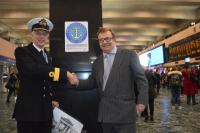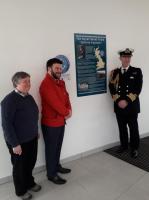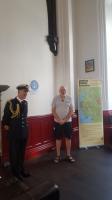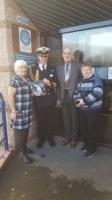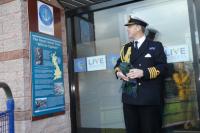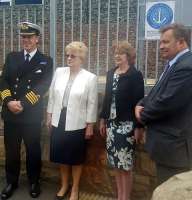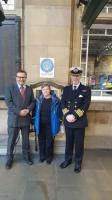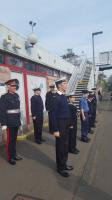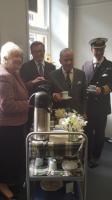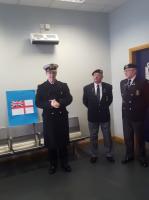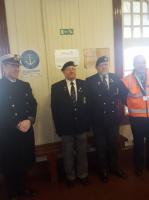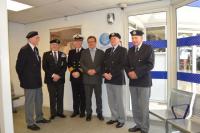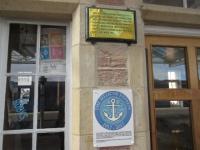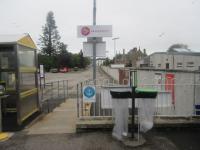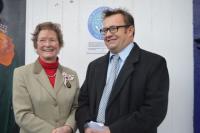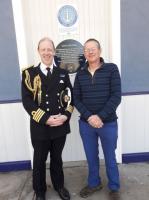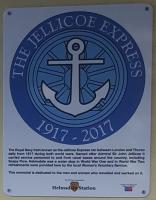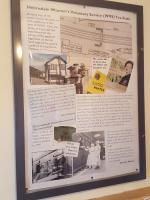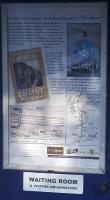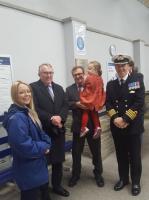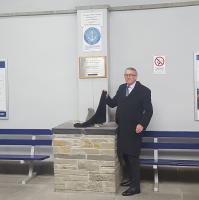Jellicoe Express
The Royal Naval Train, more commonly known as the Jellicoe Express (named for Admiral Sir John Rushworth Jellicoe (1859-1935)), was run for the Royal Navy to carry service personnel during the Great War. It linked London with Thurso for Scapa Flow where the Grand Fleet was based - 717 miles. On its journey it passed by other naval bases such as Rosyth and Invergordon. The train ran daily from 1917. It was revived in the Second World War. Due to the duration of the journey (and its purpose) it also had the name The Misery (a 6pm departure from London arrived at Thurso at 3.30pm the next day). Fortunately, there were several pauses for tea along the way.
Jellicoe Specials
This name refers to the heavy coal trains dispatched to Grangemouth for the Grand Fleet.
Jellicoe Express Plaque Unveilings
John Yellowlees
(with additional material by Railscot)We have now passed the third anniversary of the first Jellicoe Express plaque unveilings, at Edinburgh Waverley and Inverkeithing – and the first anniversary of the last, at Forsinard. From beginning to end, nineteen such events were brilliantly choreographed by Moya McDonald and starred Captain Chris Smith RN and Hon Johnny Jellicoe, with a variety of guests ranging from Lords Lieutenant and Jamie Stone MP to Geordie Adams, who had fired the train in the Second World War and did the honours at Helmsdale.

Below are photographs from each location | Euston, Crewe, Preston, Carlisle, Hawick [2nd], Galashiels, Edinburgh Waverley, Inverkeithing, Perth, Kingussie, Aviemore, Inverness, Dingwall, Alness, Invergordon, Tain, Helmsdale, Forsinard and Thurso.
Crewe
Crewe the major junction with lines running north and south, to North Wales, Liverpool and Manchester.Preston
Preston another major junction with lines to Blackburn, Leeds, York, Blackpool and Fleetwood.Carlisle
Carlisle this major junction is close to the England/Scotland border with two routes running south to London, three routes running north into Scotland one with a connection west for the link via Stranraer to Ireland. East is the line to Newcastle and south west to Cumbria, its steelworks and the Barrow Shipyard. The line ahead to Hawick is hard going but quieter and it ultimately approaches Edinburgh from the east allowing the train to continue north over the Forth Bridge without reversal.Hawick
Having reached Hawick [2nd] the landscape changes from wild moorland to farmed countryside. The plaque unveiled at the Leisure Centre is the only reminder of the passenger station.Galashiels
Although the original Galashiels [1st] station has not survived the line re-opened from Edinburgh to Tweedbank to passengers in 2015 with a new Galashiels station.Edinburgh Waverley
The main station in Scotland's capital, Edinburgh Waverley, is entered from the east. Trains run west to Glasgow Queen Street High Level, Falkirk, Corstorphine, Stirling and to north Leith and Granton - and many, many other destinations.Inverkeithing
Inverkeithing station, close to Rosyth Dockyard is reached after crossing into Fife over the Forth Bridge passing other naval locations such as Port Edgar.Kingussie
Having crossed the watershed Kingussie, the capital of Badenoch, is reached. The line follows the Spey.Inverness
Inverness, capital of the Highlands, has a port on the River Ness (where the Inverness Ammunition Depot is located), the northern end of the Caledonian Canal (with mines traffic in the Great War at US Naval Base 18) and Inverness is an important railway junction with lines radiating to Glasgow Queen Street High Level, Edinburgh Waverley, Aberdeen, Kyle of Lochalsh, Wick and Thurso.Dingwall
Dingwall at the west end of the Cromarty Firth and the junction for the line west to Kyle of Lochalsh, much involved with mines traffic in both wars.Alness
Alness was at the west end of the vast Invergordon Naval Base in the Cromarty Firth and near US Naval Base 17. A railway is laid close to the shore, in addition to the public railway, connecting the naval bases together.Invergordon
Invergordon station was north of the new Admiralty Pier and the large ship repair establishment for the Grand Fleet.Helmsdale
Having followed the coastline to Helmsdale the line turns inland climbing into the flow country.Forsinard
In the midst of the flow country Forsinard is reached, one of several such lonely outpost stations with a passing place.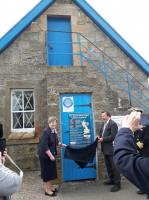
When: Tuesday 30 April 2pm - 5pm
Where: Forsinard Railway Station & Field Centre RSPB Forsinard Flows
(See poster for registration details.)' title='Poster for the final Jellicoe Express unveiling.
'Jellico Express' Centenary Celebrations
When: Tuesday 30 April 2pm - 5pm
Where: Forsinard Railway Station & Field Centre RSPB Forsinard Flows
(See poster for registration details.) John Yellowlees' src='/__cache/thumbnails/68000/68451.jpg'>
Thurso
Following reversal at Georgemas Junction the train finishes its journey at Thurso, a port in its own right and near Scrabster Harbour. A boat journey will take passengers on to Scapa Flow, the great natural harbour in Orkney.Royal Naval Association - Remembering the Jellicoe Express
